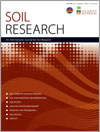SR13155Least-limiting water range of the soil seedbed submitted to mechanical and biological chiselling under no-till
Soil compaction under no-till system is considered a serious concern. To solve this problem has been used the mechanical and biological (plants with deep and aggressive rooting system) chiselling. Evaluating a soil physical quality index, we observed to be unnecessary both mechanical and biological chiselling. It is implies in reduction on the production costs since the mechanical chiselling is an expensive operation besides maintaining the no-till system undisturbed.




